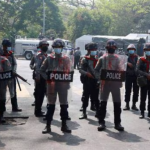Myanmar has been at war with itself for the past three years. The military coup in February 2021 unleashed a chain of violent conflicts in many parts of the country, resulting in its de facto division into a section where the military government called the State Administration Council (SAC) still rules and another where the Resistance is in charge. The latter projects that the tide is now turning in its favour. What is the ground reality? On a recent visit to Bangkok, this writer interacted with a group of regional experts on Myanmar.
The starting point is the assessment by UN Secretary-General Antonio Guterres who, on March 18, expressed deep concern about “the deteriorating situation and escalation of conflict” that has put civilians at serious risk. He highlighted two alarming trends. First, the expansion of conflict in the Rakhine State known for its “pre-existing vulnerabilities and discrimination” creates the danger of further incitement of communal tensions. Second, the forcible recruitment of youth into the military under the new conscription law in various regions and states is bound to aggravate the crisis.
Another reality check was provided by Tom Andrews, UN special rapporteur on the human rights situation in Myanmar. He spoke of a fivefold increase in air strikes by the military on its people in the past five months. He estimated that 2.7 million people stand displaced, with another 1 million likely to enter this category by the end of 2024 and asserted that 18.6 million people, including six million children, need humanitarian assistance. As against these vast needs, the flow of aid is minimal, with aid donors facing logistical challenges in a nation ravaged by conflict.
Experts agree that given the prevailing animosities, Myanmar’s stakeholders are incapable of finding ways through which de-escalation of violence and delivery and distribution of humanitarian assistance may take place smoothly. The SAC and the Resistance are much too locked into a hostile frame to agree on a modus operandi to relieve people’s suffering. They need external help which can only come from Myanmar’s ASEAN partners and willing neighbours such as China, India, and possibly Bangladesh. The internal and external players, therefore, need to create a mechanism for crafting a programme that helps alleviate people’s hardship. One neighbour, Thailand under the new government, is ready to take concrete measures such as the creation of a “humanitarian corridor” inside Myanmar as a pilot project.
Going beyond the imperative need for an early cessation of the fighting, Myanmar’s friends should also suggest a pathway to the nation’s return to normalcy. For this purpose, they need to discover a via media between two contrasting positions — the SAC’s insistence on retaining the 2008 constitution and restoration of limited democracy after “controlled” elections, and the Resistance’s vision of a fully federal democratic union with an apolitical military under a new constitution. Even before a peace formula is conceived, a pressing need exists to create an innovative mechanism for dialogue among all relevant players. ASEAN’s Five Point Consensus (FPC), agreed in April 2021, has failed to deliver, despite its best endeavours.
Some experts have argued that Myanmar presents “a regional problem.” Indeed, it does so, but only in terms of its consequences, not causes which are essentially internal. The SAC, the initiator of conflict, is now in decline and faces “an existential threat”, claim some observers. Others assert that despite its failures and setbacks, it remains a tenacious entity. The Resistance reveals a triumphant spirit, although internal divergences and lack of cohesion are viewed as its Achilles heel. An outright victory of one party against the other seems unlikely. Perhaps neither side can prevail over the other with the help of guns, planes and drones. Both need to internalise that they are part of a single nation, and it is their combined duty to work for reconciliation.
Ironically enough, Aung San Suu Kyi, serving a 33-year long imprisonment, and the National League for Democracy, which secured a landslide victory in the last elections (November 2020), hardly figure in the current discourse. Yet, in many ways, she holds the key to a possible political solution.
As a major, interested, and affected neighbour, India can and should certainly help. India’s Myanmar experts need to develop a set of practical and pragmatic proposals, infused with an accurate reading of power dynamics, geopolitical play and the country’s history. They have a role in advising policymakers in New Delhi as well as shaping the regional approach to resolving the crisis in Myanmar. Its aggravation will inevitably threaten regional peace and progress. India’s eastern neighbourhood can ill afford that calamity.
Rajiv Bhatia is Distinguished Fellow, Foreign Policy Studies, Gateway House, and a former ambassador.
This article was first published by The Indian Express.
Support our work here.


